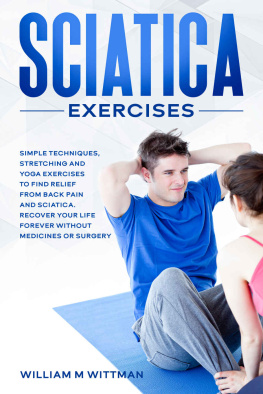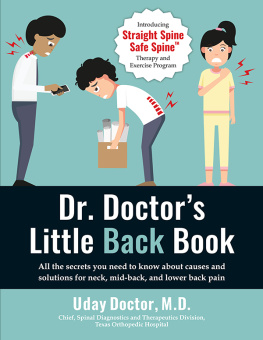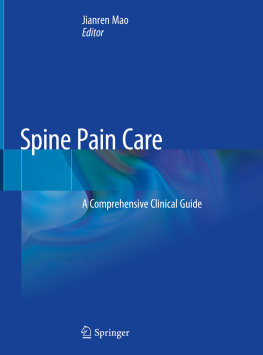Spine health restoration program
Over 100 exercises to help you get rid of pain forever and improve body functions
Samuel Greenberg
Text Copyright 2020
Warning the author is not responsible for any undesirable consequences in case of the use of medical products without consultation with the doctor. Every attempt was made to provide accurate data. All information provided in this book does not replace medical advice.
Disclaimer notice:
Please note information in this book for educational purpose only.
Every attempt has been made to providing accurate and complete information. Readers recognize that creator is not participating in rendering legitimate, money related or proficient guidance.
By reading this book reader agrees that under no circumstances are the author is not responsible of direct or indirect loses as a result of using information in this book including - but not limited - any possible errors, omissions and inaccuracies.
Annotation
Poor posture, osteochondritis, sciatica, headaches, numbness of the arms and legs, pain in the joints - these are all manifestations of diseases associated with the spine. Spine is the foundation of our health. In this book, you will find the most comprehensive selection of therapeutic movements necessary to restore the lost functions of your back.
If you have not had a serious spinal injury, then the best that can be offered from the entire arsenal of remedies is special exercises for spine. This is the most effective treatment that will completely relieve you of pain and improve the general condition of your body and the functions of all organs.
Sets of exercises include: posture correction; relieving pain; correction of pathologies of all parts of the spine (cervical, thoracic, lumbar, hip); prevention of occupational diseases of the back.
Table of contents:
Chapter 1. Introduction
Recently, more and more often you can hear the phrase: "Heal the spine - and you will get rid of a lot of diseases." And there is a great deal of truth in this. The spine has several functions. Firstly, it protects the spinal cord from damage, from which nerves extend to muscles and internal organs. Secondly, it serves as a support for the body, supports the neuromuscular apparatus. Thirdly, it provides movement of the head, neck, upper and lower limbs, the whole body.
And therefore, the slightest violation in the spine adversely affects the state of other organs of the body, it can even lead to disharmony between the physical and mental state.
Unfortunately it's true. According to studies, unwanted changes in the spine occur already in adolescence and intensify by the age of 40-50, causing spinal diseases that occur in about 80% of men and 60% of women.
To really understand what is happening in our body and what is the cause of the ailment let's remember the structure of the spine.
The human spine consists of 33 vertebrae. They form 5 sections: cervical (7 vertebrae), thoracic (12 vertebrae), lumbar (5 vertebrae), sacral (5 vertebrae fused into one bone - sacrum) and coccygeal (most often - one bone from 3-4 vertebrae), Fig. 1.
Fig. 1
You can see that the vertebral column looks like the letter "S". This shape our spine took after the person "got to his feet." Thanks to this form, part of the human weight load is transferred to the paravertebral ligaments, and the tremors when you are running or walking are softened.
The vertebrae are connected by cartilage and ligaments. Therefore, the spine can bend, unbend, etc. The most mobile parts of sine are cervical and lumbar sections. The thoracic section is less mobile. In the middle of each vertebra is a vertebral process, from which, in turn, lead the lateral processes.
They protect the spine from external shocks. From the spinal cord through the holes in the arches of the vertebrae, nerve fibers depart, connected with different parts of the body.
The sensory nerve roots, which control taste, touch, smell, hearing, and vision, are attached to the back of the spinal cord, while the motor nerve roots, which control muscle function in the body, are attached to the front. In this way, all nerves and blood vessels are directed from the spine to the corresponding part of the body.
Now imagine that your vertebrae have shifted slightly, compressed the nerves and blood vessels that extend from them (Fig. 2).
Fig. 2
What happened next? That's right, their normal work was interrupted, as blood circulation was disturbed, pinched nerves were numb, and hence the appearance of diseases of those organs with which nerves and blood vessels are connected. And all this is due to subluxation, that is, due to that very displacement. It is clear that the greater the displacement, the worse the person feels, the more serious the illness.
It is easy to guess that most often subluxations occur in the cervical region, since it is the most mobile. In practice, this means that as a result, problems arise with the eyes, neck, lungs, heart and some other organs, because nerves of this spinal section are connected to the mentioned above organs. For example, a subluxation of the 4th cervical vertebra (it can be found in the picture) will affect the condition of those organs that have just been listed, as well as the condition of the diaphragm of the liver, spleen, adrenal glands, teeth, throat, nose and ears.
Most often, the 1st and 4th cervical vertebrae, the 2nd, 5th and 10th thoracic vertebrae, the 2nd and 5th lumbar vertebrae are injured. However, this does not mean that the rest of the vertebrae always remain intact and safe.
This is why subluxations need to be corrected. In addition, you need to monitor your posture. Why - you will understand a little later. It should be noted that below will be presented sets of exercises not only to correct posture, but also to stretch the spine, restore its functions and relieve pain, exercises for prevention. For now, remember the rules for doing the exercises.
Chapter 2. Preparation for exercises
Exercise rules
Most importantly, before starting to exercise, be sure to see a doctor, especially if you are experiencing severe, sharp pain in the spine.
Be sure to do a light warm-up before moving on to a set of exercises. Consider your energy. During the first week, and possibly more, do all the exercises slowly and without straining, do not exercise with force and overcoming pain in the spine. But muscle pain is a natural phenomenon, but after a few days it will go away.
When performing a movement designed for the part of your spine that suffers the most, do not make sudden movements. Measure the load against your physical capabilities. This means that when you decide how many reps are right for you for a given exercise, you need to consider your age, severity of illness, and level of fitness.
Increase the load gradually. The range of motion in the first days should be minimal.
You can rest a little after exercise, but the set of exercises should be done completely. If you feel that you are not yet sufficiently prepared to perform the exercises, or you have poorly developed vestibular apparatus, you can hold onto the back of the chair while doing the exercises.
Do all the exercises with joy and pleasure!
How to check for correct posture
Even younger students know how to check if your posture is correct or not. Stand with your back to the wall, legs slightly apart and arms hanging freely. The back of your head, shoulders, calves and heels should touch the wall. Now try to press against the wall so that the distance between it and the lower back is no more than the thickness of your finger. Do you feel that the stomach seems to be picking up on its own, the neck is slightly extended, and the shoulders are straightened?














